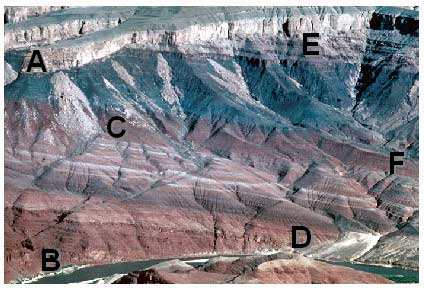Assessing Temporal Thinking and Learning
Introduction

The first step in assessing temporal learning is establishing a set of measurable learning goals. One way to write measurable goals is to use very clear verbs and focus on actions. "Students will understand geologic time" is difficult to assess. In contrast, "Students will be able to use Steno's principles to interpret the sequence of geological events evident in a cross section they have not seen before," focusing on an action students should be able to perform, suggests its own assessment. Writing measurable goals, such as this one, requires that you carefully think through and articulate exactly what knowledge or skill you want your students to exhibit or perform. As a result, developing strong learning goals is often an iterative process, involving some refinement each time you teach a course or subject.
Once you have a list of learning goals, you can choose from existing assessment instruments or develop your own.
Existing Assessment Instruments
There are many instruments that already exist, designed to measure students' temporal thinking and learning. You may find that one or more of these are already well-matched to your learning goals, or that modifications would allow you to use them to measure your students' learning.
- We have a collection of assessments with a focus on geologic time, contributed by geoscience faculty.
- Faculty at our 2012 workshop on Teaching About Time developed a baseline assessment that can be used to assess your students' knowledge and skills at the beginning of a course and a page about mastery assessment that provides examples of the kinds of tasks you can have students do to measure their mastery of temporal concepts.
- The Geoscience Concept Inventory includes some items related to geologic history and geologic time. Read about the development of the GCI in Libarkin and Anderson, 2005.
- The Geological Time Aptitude Test (GeoTAT), developed by Jeff Dodick and Nir Orion for their research on temporal learning, is a validated questionnaire that measures a student's ability to reconstruct depositional history. The questionnaire is reproduced in its entirety in the appendix of Dodick and Orion, 2006.
- In the process of researching Grand Canyon National Park visitors' ability to learn about geologic time along the Trail of Time, Steve Semken et al. (2009) developed assessments of the ability to negotiate time scale changes and reconcile horizontal and vertical time scales.
Developing New Assessments

If you find that you need or want to develop your own assessment instruments to measure temporal learning, here are some suggestions on how to get started.
- Work backward from the (specific, measurable) learning outcomes you want to observe. Spend some time thinking, and perhaps talking with colleagues, about what would convince you that your students have developed a deep understanding of the temporal concepts you are teaching. Work to develop assessments that allow your students to show you that they can do whatever that is.
- Use proven strategies. Research on learning has demonstrated many effective methods of assessing student learning, including
- Concept sketching (Johnson & Reynolds, 2005): have students create and/or annotate geological sketches. Annotations can include labeling features, processes, concepts, and interrelationships.
- Concept mapping: have students create concept maps -- abstract diagrams showing the relationships between concepts.
- Use a ConcepTest - a single multiple choice question that students answer on the spot - for immediate in-class assessment of whether students "get" an important concept.
- Just in Time Teaching: students answer a small set of web-based questions on upcoming course material outside of class and submit their responses online a few hours before class begins. The instructor reviews the students' responses and develops in-class active-learning exercises targeting learning gaps - "just in time" for class.
- Have your students take quizzes or exams in two stages. In a two-stage exam, students answer the questions individually and hand in their work, and then they answer the same questions, new questions, or both, in pairs or groups. Students are highly motivated to learn from their peers during the test, and instructors have the opportunity to listen to discussions, thus providing a window into their conceptual understanding.
If you have written an assessment related to time, please share your assessment and we will add it to our collection.
References
Dodick, J. and N. Orion (2006). Building an understanding of geological time: A cognitive synthesis of the "macro" and "micro" scales of time, in Manduca, C.A. and D.W. Mogk, eds., Earth and Mind: How Geologists Think and Learn about the Earth: Geological Society of America Special Paper 413, pp. 77-93.
Johnson, J. and S. Reynolds (2005). Concept Sketches - Using Student- and Instructor-generated, Annotated Sketches for Learning, Teaching, and Assessment in Geology Courses. Journal of Geoscience Education, v. 53, p. 85-95.
Libarkin, J.C., and S.W. Anderson (2005). Assessment of learning in entry-level geoscience courses: Results from the Geoscience Concept Inventory. Journal of Geoscience Education, v. 53, p. 394-401.
Semken, S., Dodick, J., Frus, R., Wells, M., Perry, D., Bryan, J., Williams, M., Crow, R., Crossey, L., & Karlstrom, K. (2009, November-December). Studies of informal geologic time learning at the "Trail of Time" in Grand Canyon National Park. Informal Learning Review, 1(99), 1-5.

